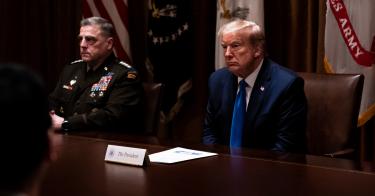One of Donald Trump’s major achievements was reversing the decline of the armed forces and beginning the long, vital process of rebuilding them. In cooperation with Congress, he added $100 billion to the defense budget over two years, and initiated reforms to enable the Pentagon to more effectively deter aggressors, especially China.
There’s a long way to go before the job is complete, of course. Four years was never going to be enough time to reverse the decades of neglect and underfunding which hurt the armed forces even before the disastrous sequester of 2013-2018. But for the first time in a long time, a president actually managed to increase the present and future readiness of the armed forces during his term in office.
>>> Increasing Defense Budgets to Maintain America's Military Security a Priority
Perhaps even more important, Trump’s record demonstrates that a “peace through strength” agenda can unify the political right while also earning support from the center and at least parts of the left as well.
Let’s look at how Trump’s defense agenda was received by conservatives.
Republican “Never Trumpers” defined themselves by their disdain for the president. They attacked him for a lot of things, but increasing the defense budget, improving readiness, establishing the Space Force, increasing the size of the Navy, building out missile defense, buying next generation equipment and giving military commanders more discretion to prosecute regional conflicts, were not among them.
On the other end of the conservative political spectrum are people deeply skeptical of military adventurism. Some are flat-out isolationist. Nevertheless, they also supported the president. They had less issue with his determination to invest in defense, because he paired this with a commitment to prudence in the application of force. Besides, to the extent that patriotic Americans want to pull back from foreign commitments, and form a kind of Fortress America, it makes sense for them to also want a damn strong fortress.
The center of the conservative movement is rooted in Reagan’s legacy of “peace through strength.” They supported Trump’s defense agenda because in all essential aspects it was their agenda.
Nor is a strong national defense supported only on the conservative side of the political spectrum. Trump could not have escaped the defense sequester, or established the Space Force, or initiated most of his other Pentagon reforms, without support from Democrats.
That’s no historical anomaly. Before Ronald Reagan was elected president in 1980, a coalition of both Democrats and Republicans worked on plans to rebuild America’s post-Vietnam military.
Going forward, support for a robust defense budget should continue to be not just acceptable but popular with a large cross section of political leaders, and for three reasons.
First, in an age of great power competition, when a strong national defense is pivotal to keeping America safe, free and prosperous, leaders of good will know that increased funding for a reformed Pentagon is the one sine qua non to achieving both security and peace.
>>> Defense Budget Debates Should Start With Strategy, Not Dollars
Second, the major objection to increasing the defense budget has always been that the government couldn’t afford it—that “fiscal restraint” requires freezing or cutting the defense top line. That argument was never sound; as the defense sequester has shown, it always ends up costing more to restore current or future readiness than it would have cost to maintain readiness in the first place.
But it’s farcical now, after $4 trillion dollars have been borrowed in the last year alone, to suggest that the government cannot afford a 3-5% real increase in the defense budget.
Finally, the American people want to be secure, and one of the few institutions they still trust to keep them secure is the armed forces. In fact, America’s military is one of the few government institutions the American people still trust for anything at all.
Pundits will argue for a long time about why Donald Trump lost his race for reelection, but nobody believes he lost because of his support for the armed forces. He was never attacked for his defense agenda, and not just because peace through strength is the right thing to do. It’s also very popular.
The American people know that building the capabilities of the armed forces while using them sparingly is the best path to peace and the most certain guarantee of security. In fact, if Donald Trump had talked about it more himself, he might have won.
This piece originally appeared in ArcaMax





